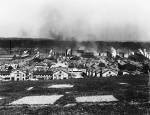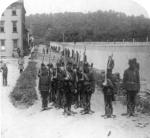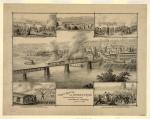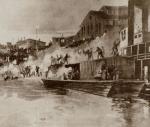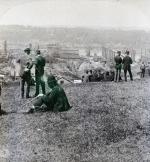![header=[Marker Text] body=[On the morning of July 6, 1892, on orders of the Carnegie Steel Co., 300 Pinkerton agents attempted to land near here; strikers, citizens repulsed them. Seven workers, three Pinkertons were killed. 8,000 state militia arrived July 12; by November the strike was broken.] sign](http://explorepahistory.com/kora/files/1/10/1-A-235-139-ExplorePAHistory-a0h6r9-a_450.jpg)
Mouse over for marker text
Name:
Homestead Strike
Region:
Pittsburgh Region
County:
Allegheny
Marker Location:
880 E Waterfront Dr., Munhall
Dedication Date:
July 1, 1992
Behind the Marker
"If Pittsburgh is hell with the lid off," observed Arthur Shadwell, an English visitor, "Homestead is hell with the hatches on."
Homestead astonished Shadwell even a dozen years after the infamous 1892 strike. Bad enough was the physical gloom of the mill town, the grinding twelve-hour days, and the workers' "wretched hovels." Shadwell also saw the pent up human fury. "The human element demands recognition and will obtain it." Recognition of the human element, in the form of full-fledged unionism, would be more than four decades in coming.
The Homestead mill entered the Carnegie realm in 1883, just two years after it's construction, and was a site of persistent labor unrest. After striking in 1889, Homestead's workers won a three-year contract that recognized the union and provided a favorable wage scale. But both
persistent labor unrest. After striking in 1889, Homestead's workers won a three-year contract that recognized the union and provided a favorable wage scale. But both  Henry Clay Frick and
Henry Clay Frick and  Andrew Carnegie agreed that when the contract expired in July 1892, they would break the union and restore their complete control over the mills. It was to be a showdown. The men's wages would be cut, the union must go - and the company would import Pinkerton guards to protect the strikebreakers and impose the company's will. On all these matters, Carnegie left detailed instructions with Frick before leaving for Scotland on his usual summer trip.
Andrew Carnegie agreed that when the contract expired in July 1892, they would break the union and restore their complete control over the mills. It was to be a showdown. The men's wages would be cut, the union must go - and the company would import Pinkerton guards to protect the strikebreakers and impose the company's will. On all these matters, Carnegie left detailed instructions with Frick before leaving for Scotland on his usual summer trip.
Frick prepared for the conflict by encircling the mill with an eleven-foot fence topped with barbed wire, ordering up the Pinkertons, and shutting down the open hearth, armor, and rolling departments in the last days of June. By July 1 the lockout was on. The New York Times predicted a "fight . . . to the death" between Carnegie Steel and the union. Yet for five long days, while rumors of every description swirled around town, all was calm. While unionists hoped for a negotiated settlement, the company had set the stage for a violent confrontation.
On July 6, the company tried to move 300 Pinkerton guards into the heavily fortified mill, floating them up the river on two large covered barges. The plan was in the early morning hours to land the Pinkertons, accompanied by John A. Potter, the Homestead work's superintendent, secure the mill, then bring in strikebreakers.
But striking workers and townspeople caught wind of the scheme, moved into positions around the river landing, and pinned the Pinkertons' barges in a withering crossfire. In twelve hours of fierce battle, seven strikers and three Pinkertons were killed. That afternoon, John McLuckie, the town's burgess and a union man, arranged a truce. Shortly after 4 p.m. the Pinkertons were marched though the town to safe buildings on Sixth Avenue. "We were clubbed at every step," one of them stated.
In twelve hours of fierce battle, seven strikers and three Pinkertons were killed. That afternoon, John McLuckie, the town's burgess and a union man, arranged a truce. Shortly after 4 p.m. the Pinkertons were marched though the town to safe buildings on Sixth Avenue. "We were clubbed at every step," one of them stated.
For several days, union men controlled the entire town - including the mill. Residents refused to be deputized into the service of restoring order and suppressing the strike. The swirl of rumors ended on Tuesday, July 12, when the state militia arrived in town by train. It was a force of occupation. Some 4,000 heavily armed troops marched into position on a hill above the mill (today the site of Homestead's Carnegie Library) and aimed Gatling guns, artillery pieces, and Springfield rifles at the mill, still held by the strikers. An equally large group moved into position across the river. With the militia commander now in charge of the entire town, local officials jailed the strike leaders.
union men controlled the entire town - including the mill. Residents refused to be deputized into the service of restoring order and suppressing the strike. The swirl of rumors ended on Tuesday, July 12, when the state militia arrived in town by train. It was a force of occupation. Some 4,000 heavily armed troops marched into position on a hill above the mill (today the site of Homestead's Carnegie Library) and aimed Gatling guns, artillery pieces, and Springfield rifles at the mill, still held by the strikers. An equally large group moved into position across the river. With the militia commander now in charge of the entire town, local officials jailed the strike leaders.
The two sides then settled in to a waiting game that lasted five months. The ultimate outcome, however, could not have been much in question. Frick and Carnegie closed ranks against the union. On July 11, Frick got a cable from Carnegie in Scotland: "Am with you to end[,] whether works run this year, next or never. No longer question of wages or dollars." Public sentiment, initially with the workers in their resistance against the hired guns, turned against them following anarchist Alexander Berkman's attempted assassination of Frick. The Amalgamated Association was defeated. Homestead, after that fleeting moment of workers' control, became an enduring symbol of corporate domination. Indeed, memories of the
Amalgamated Association was defeated. Homestead, after that fleeting moment of workers' control, became an enduring symbol of corporate domination. Indeed, memories of the  strike's victims endured longer than the mill itself.
strike's victims endured longer than the mill itself.
Today, the Pump House, a focal point of the 1892 battle, is the only building to survive the razing of the great mill and its replacement by The Waterfront, a large shopping complex. Interpretive exhibits and educational programs are presented through a cooperative effort of the Battle of Homestead Foundation (representing organized labor) and the Steel Industry Heritage Corporation.
Homestead astonished Shadwell even a dozen years after the infamous 1892 strike. Bad enough was the physical gloom of the mill town, the grinding twelve-hour days, and the workers' "wretched hovels." Shadwell also saw the pent up human fury. "The human element demands recognition and will obtain it." Recognition of the human element, in the form of full-fledged unionism, would be more than four decades in coming.
The Homestead mill entered the Carnegie realm in 1883, just two years after it's construction, and was a site of
Frick prepared for the conflict by encircling the mill with an eleven-foot fence topped with barbed wire, ordering up the Pinkertons, and shutting down the open hearth, armor, and rolling departments in the last days of June. By July 1 the lockout was on. The New York Times predicted a "fight . . . to the death" between Carnegie Steel and the union. Yet for five long days, while rumors of every description swirled around town, all was calm. While unionists hoped for a negotiated settlement, the company had set the stage for a violent confrontation.
On July 6, the company tried to move 300 Pinkerton guards into the heavily fortified mill, floating them up the river on two large covered barges. The plan was in the early morning hours to land the Pinkertons, accompanied by John A. Potter, the Homestead work's superintendent, secure the mill, then bring in strikebreakers.
But striking workers and townspeople caught wind of the scheme, moved into positions around the river landing, and pinned the Pinkertons' barges in a withering crossfire.
For several days,
The two sides then settled in to a waiting game that lasted five months. The ultimate outcome, however, could not have been much in question. Frick and Carnegie closed ranks against the union. On July 11, Frick got a cable from Carnegie in Scotland: "Am with you to end[,] whether works run this year, next or never. No longer question of wages or dollars." Public sentiment, initially with the workers in their resistance against the hired guns, turned against them following anarchist Alexander Berkman's attempted assassination of Frick. The
Today, the Pump House, a focal point of the 1892 battle, is the only building to survive the razing of the great mill and its replacement by The Waterfront, a large shopping complex. Interpretive exhibits and educational programs are presented through a cooperative effort of the Battle of Homestead Foundation (representing organized labor) and the Steel Industry Heritage Corporation.




